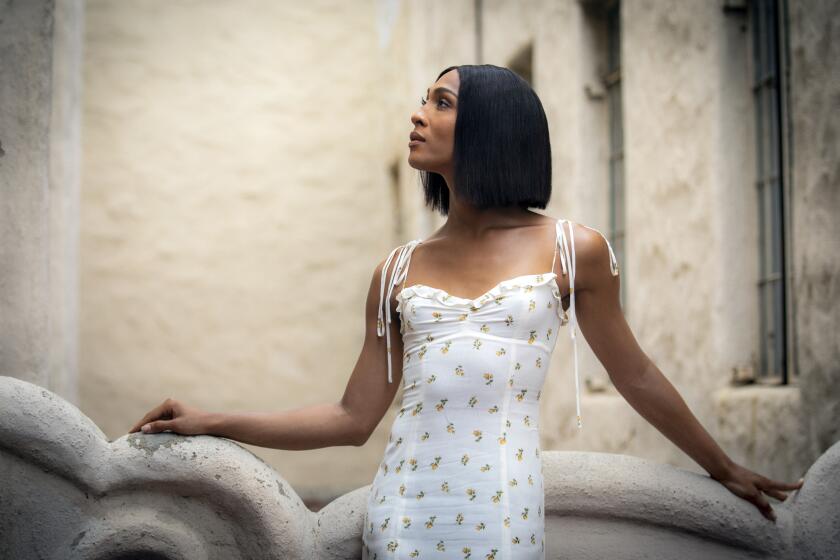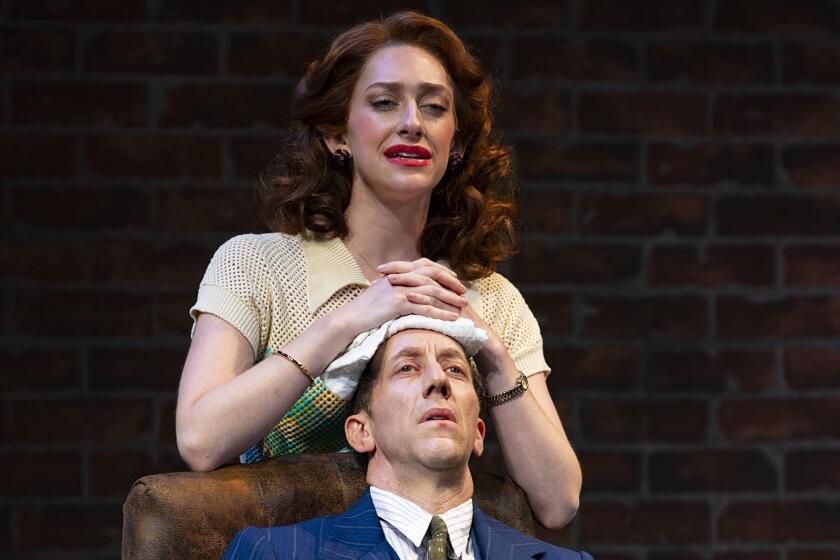- Share via
“Strange.” “Weird.” “Exotic little beauty.” “Like something from another world.”
These are ways in which the plant of “Little Shop of Horrors” is initially described by its characters. They’re perplexed by its presence, its mysterious origins, its unidentifiable genus. But the botanical fascination is so enticing that it boosts the business of a skid row flower shop — and convinces its caretaker to commit a bit of murder in exchange for fame and fortune.
Countless stagings of the Howard Ashman-Alan Menken musical have remained visually devout to the sprout that debuted off-off-Broadway in 1982. Based on the 1960 Roger Corman cult classic and popularized by Frank Oz’s 1986 musical film, the Faustian fable has been mounted again and again with a green, podlike growth resembling a Venus flytrap and a bountiful head of lettuce.
“The classic look can be nostalgic but also predictable,” said Mike Donahue, who directed the Pasadena Playhouse production set to close Sunday. “All of the language that’s in the piece is about how the plant stands out, how it catches people’s eyes immediately when people are walking by. There’s gotta be something about it that, in this drab and depressed and bleak world, just pops.”
The Playhouse questioned those optical expectations and answered with a radical redesign of the plant, Audrey II, nicknamed Twoey. Housed in a large tomato can, its flower is a fantastic fuchsia hue, the five appendage-like tendrils glistening and sparkling. When closed, a bud of polka dot petals resembles a head with lips. It opens into a lily with a playful yellow tongue. This Twoey is indeed a new sight for those onstage and in the audience, and now that the run is ending, her secrets are being revealed in new photos presented exclusively here.
“I wanted to make something that seems alien and extraterrestrial but also that gives an emotional reaction — you can’t help but smile,” said Sean Cawelti, who led the show’s puppet design, direction and choreography. “And when the plant opens its petals for the first time and reveals what’s inside, it’s not inherently scary but surprisingly whimsical and magical.”
Fear is the furthest thing from anyone’s mind during the song “Grow for Me.” A first version of Twoey — which “faints” via remote control — is swiftly swapped for a rod puppet plant with hard-to-spot cables controlled by three puppeteers under a metal table.
Throughout the number, the canned plant waddles like a curious infant learning her own body. Her neck and arms reach for shop clerk Seymour’s wounded finger. Seymour isn’t bullied into pacifying her thirst for blood; rather, he’s seduced. And the blood makes her so happy — oh, how she shakes with glee after a few drops.
“The movement the puppeteers were doing were almost puppylike, like a little dog begging for a treat,” said George Salazar, who plays Seymour. “If we set up a warm and sweet and adorable Audrey II, it allows the audience to feel conflicted about who they’re rooting for.”
The Playhouse’s Twoey is voiced offstage by Amber Riley, whose “R&B thunder, which doesn’t take no for an answer, turns this unusual-looking potted purple flytrap into a symbol for a murderous appetite that cannot be sated,” wrote Times critic Charles McNulty.
Riley said in an interview that Twoey is usually played by a bass-baritone male. “I’m definitely a female soprano but I love a good challenge,” she said with a laugh.
Throughout rehearsals, Riley worked closely with the puppeteers to stay as connected to the creature as possible, even when she’s singing in her booth in the wings.
“In my mind, I’m onstage with everyone else, so I’m acting it out in my booth back there,” she said. “I try to come at it with the same energy that they’re all expelling onstage.”
As the story evolves, so does Twoey, who quickly outgrows her can and rarely appears in her entirety. During the rollicking song “Feed Me,” she is played by five puppeteers who manipulate oversize tendrils and a toothier flower head. Later, six thick marionette tendrils, some around 80 feet long, hang from the proscenium and hover over shop owner Mushnik before he’s pulled into an upstage darkness.
Twoey is later operated as a giant, menacing crane with multiple sets of teeth, the striped pajama pants of Mj Rodriguez’s Audrey still loitering in Audrey II’s throat. Floor-to-ceiling curtains form just her mouth.
“Rather than making the audience literally watch people get eaten by the plant every time, we wanted to keep a sense of mystery and felt it would seem dicier and more dangerous if you didn’t see it all at once,” Donahue said. “We were also interested in flirting with something that’s more psychological. Could this all be inside of his head? Is he the only one who’s seeing it and really hearing her voice? Does the plant have the ability to sort of pick and choose to whom it reveals itself?”
Mj Rodriguez, who costars with George Salazar and Amber Riley at Pasadena Playhouse, was surprised — and a little scared — by the offer.
With each phase, the puppeteers — Tyler Bremer, Kelsey Kato, Tim Kopacz, Sarah Kay Peters and Paul Turbiak, dressed in black velvet bodysuits — strategically hide between the light curtains bathing the plant’s parts and prey. This quintet opens and closes the show by putting on and taking off black hoods — bookends that acknowledge their work in the production.
“I feel like I’m onstage with one being,” Salazar said. “It’s incredible how they’re able to create a singular entity so flawlessly.”
The show’s puppets were constructed mainly in a rented space in Tujunga, built by members of the L.A. Guild of Puppetry. “So many people donated their time to make the show happen,” said Cawelti, who thanked the puppeteers and puppet makers with an Easter egg: their names as the ingredient list of Twoey’s tomato can.
Donahue has words for anyone disappointed in their take on the frequently produced musical, which also featured a notably diverse cast and played its story lines with more sentimentality than satire.
“I love it when people are annoyed or pissed off that we didn’t do the thing they expected to see, but it makes me a little sad or disheartened when they then stop short of asking why that choice might have been made,” he said. “I think the mark of truly great material is it can withstand many different approaches; we don’t just have to be repeating somebody else’s choices that were made 30-some-odd years ago.”
Salazar said he hoped audiences have left “feeling like they seen this show for the first time.”
Michael Ritchie, the artistic director of Center Theatre Group, has brought exciting theater programming, but why hasn’t he made Los Angeles a greater player in the national conversation?
“And I also hope this sparks a conversation among commercial theaters — specifically in New York, where oftentimes musicals will be revived in kind of the same way they were originally produced,” he said. “Why aren’t we taking more risks? Why aren’t we thinking a little more outside of the box?
“Yeah, I know things cost money, and I know that’s scary, I totally get it. But what I love about art is that when you take a risk, whether blindly or preplanned, and people take a liking to it, it’s incredibly thrilling and rewarding.”
'Little Shop of Horrors'
Where: Pasadena Playhouse, 39 S. El Molino Ave.
When: 8 p.m. Friday, 2 and 8 p.m. Saturday, 2 and 7 p.m. Sunday. Ends Sunday.
Tickets: $25 and up
Info: (626) 356-7529, PasadenaPlayhouse.org
Running time: 2 hours (one intermission)
You always can find our latest theater news and reviews at latimes.com/theater.
More to Read
The biggest entertainment stories
Get our big stories about Hollywood, film, television, music, arts, culture and more right in your inbox as soon as they publish.
You may occasionally receive promotional content from the Los Angeles Times.













